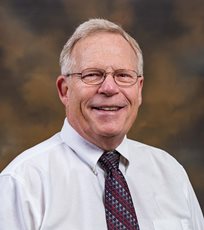Patient Story - Thomas Walser
 Thomas Walser found out in early 2020 that not everyone who experiences a heart attack feels pain in the chest. He had just awakened to begin his day when he felt a tight knot between his shoulder blades. After unsuccessfully attempting to loosen the knot, the pain grew more severe. He then asked his wife to call Emergency Medical Services (EMS) because he was unsure what was causing the pain and felt immobilized. The emergency medical technicians (EMTs), who had quickly arrived at his home, performed a electrocardiogram (EKG). Within minutes, they knew for certain that Thomas was experiencing a heart attack.
Thomas Walser found out in early 2020 that not everyone who experiences a heart attack feels pain in the chest. He had just awakened to begin his day when he felt a tight knot between his shoulder blades. After unsuccessfully attempting to loosen the knot, the pain grew more severe. He then asked his wife to call Emergency Medical Services (EMS) because he was unsure what was causing the pain and felt immobilized. The emergency medical technicians (EMTs), who had quickly arrived at his home, performed a electrocardiogram (EKG). Within minutes, they knew for certain that Thomas was experiencing a heart attack.
Licking Memorial Health Systems (LMHS) has been working with local EMS departments for nearly two decades to equip crews with EKG machines. EKG readings are sent directly to the Licking Memorial Hospital (LMH) Emergency Department where the cardiac response team is alerted and readied to perform lifesaving procedures within minutes of the patient’s arrival. For Thomas, the EMTs determined there was a blockage in the left anterior descending artery – a condition often referred to as the ‘widowmaker.’ This particular type of heart attack can be fatal due to that particular artery’s significant role in providing blood to the heart.
“The team of EMTs were very knowledgeable and treated me kindly while I was in transit,” Thomas said. “They kept in constant communication with LMH while keeping me informed of the steps being taken to prepare the operating room for an emergency cardiac catheterization.” During a cardiac catheterization, a physician guides a flexible tube through a blood vessel to the heart to diagnose or treat certain heart conditions, such as blockages or irregular heartbeats.
Thomas remained alert throughout the trip from his home in Thornville to LMH, and was aware of his surroundings when LMH staff and the EMTs began moving him to the catheterization laboratory. “I recognized the hallway, and then I just passed out,” Thomas said. Cardiology Services Nurse Practitioner Leslie Solomon, APRN-CNP, was assisting in the transport when Thomas’ heart stopped beating. She quickly activated a code blue – an emergency response that alerts a team of responders to assist in providing life-saving care. The team works in complete coordination to revive the patient. In this instance, they had to twice use a defibrillator to administer a controlled electric shock in order to allow restoration of the normal rhythm of Thomas’ heart.
After regaining consciousness, Thomas noticed an LMH staff member was shaving his wrist. “I had undergone a catheterization procedure 15 years ago, and the physician had accessed the heart through a vein in my groin,” Thomas said. “I was pleased to discover the procedure could be performed by utilizing the radial artery, located in the wrist.” Radial access to the arteries in the heart offers quicker recovery time and decreases the risk of bleeding. Hassan Rajjoub, M.D., performed the procedure placing a stent in Thomas’ heart to unblock the artery and restore blood flow. Thomas was taken to the Intensive Care Unit to recover.
The discomfort of intubation and being immobile made Thomas determined to regain his strength. “It did not take me long to start walking,” Thomas remembered. “The corridors form a natural circle, so I would loop around the ICU. As I walked past a few of the nurses, I overheard one proclaim her disbelief that I was the same patient who had nearly died in the hallway just the day before.” Thomas was able to recover quickly and was released from LMH four days after his catheterization.
Dr. Rajjoub recommended that Thomas visit the Licking Memorial Cardiac Pulmonary Rehabilitation Clinic to receive physical therapy. Staff members at the Clinic closely monitor patients as they exercise to ensure no undue stress is placed on the heart. Thomas visited the facility for four weeks until stay-at-home orders were issued due to the COVID-19 pandemic. “The staff members at the Rehabilitation Center were very caring,” Thomas shared. “They relate to every patient on a personal level, and are able to interact with all types of personalities. It was a wonderful experience.” Even after just a few weeks at the Clinic, Thomas felt well enough to continue exercising on his own at home using a treadmill.
Not long after his heart attack, Thomas returned to his law practice and work as a magistrate with the Perry County Juvenile Court. “I cannot express enough thanks to God, to my wife, Su, my son, my brother, my pastor, his wife and other very close friends who immediately activated prayer chains and comforted my wife at the Hospital. They are certainly prayer warriors. I absolutely believe God worked a miracle through Dr. Rajjoub, the EMTs and the staff at LMH, and I also cannot express enough thanks to them,” Thomas said. “Dr. Rajjoub told me that he knew my condition was potentially fatal when he saw the EKG readings. I feel blessed to have survived and received care from such knowledgeable and caring professionals. They saved my life.”
Thomas continues to work to better his health by walking with his wife of 42 years, Su, and spending time with his six grandchildren. He also enjoys playing golf when he has the opportunity and cheering for The Ohio State Buckeyes. Thomas is an OSU graduate and alumnus of The OSU Marching Band.
| Posted On : 2/1/2022 9:00:00 AM